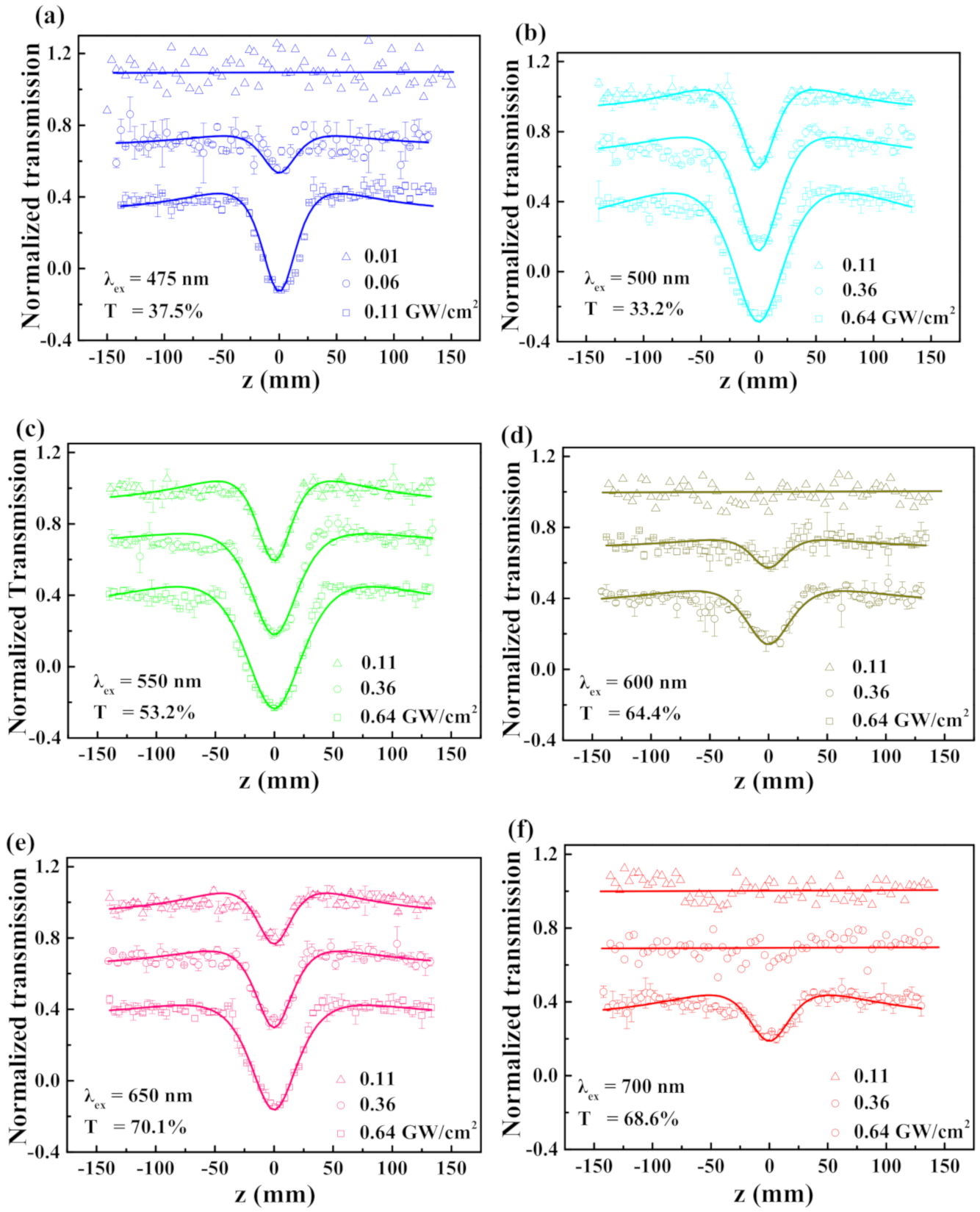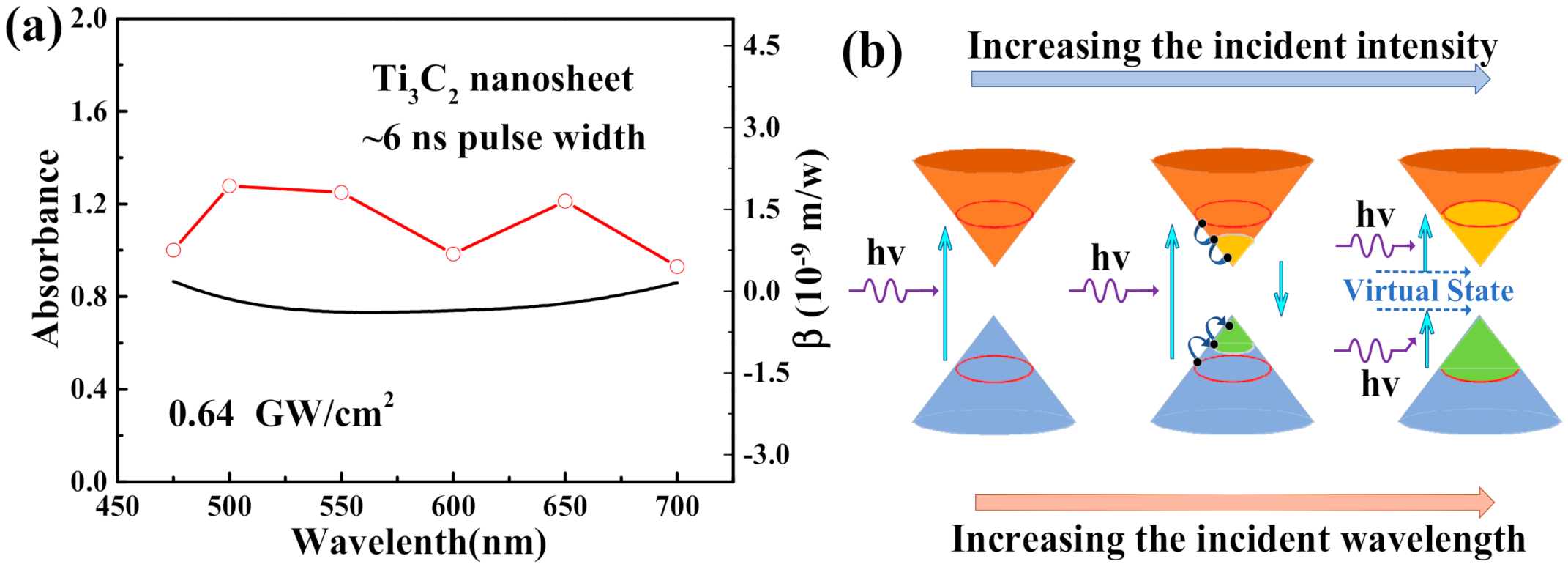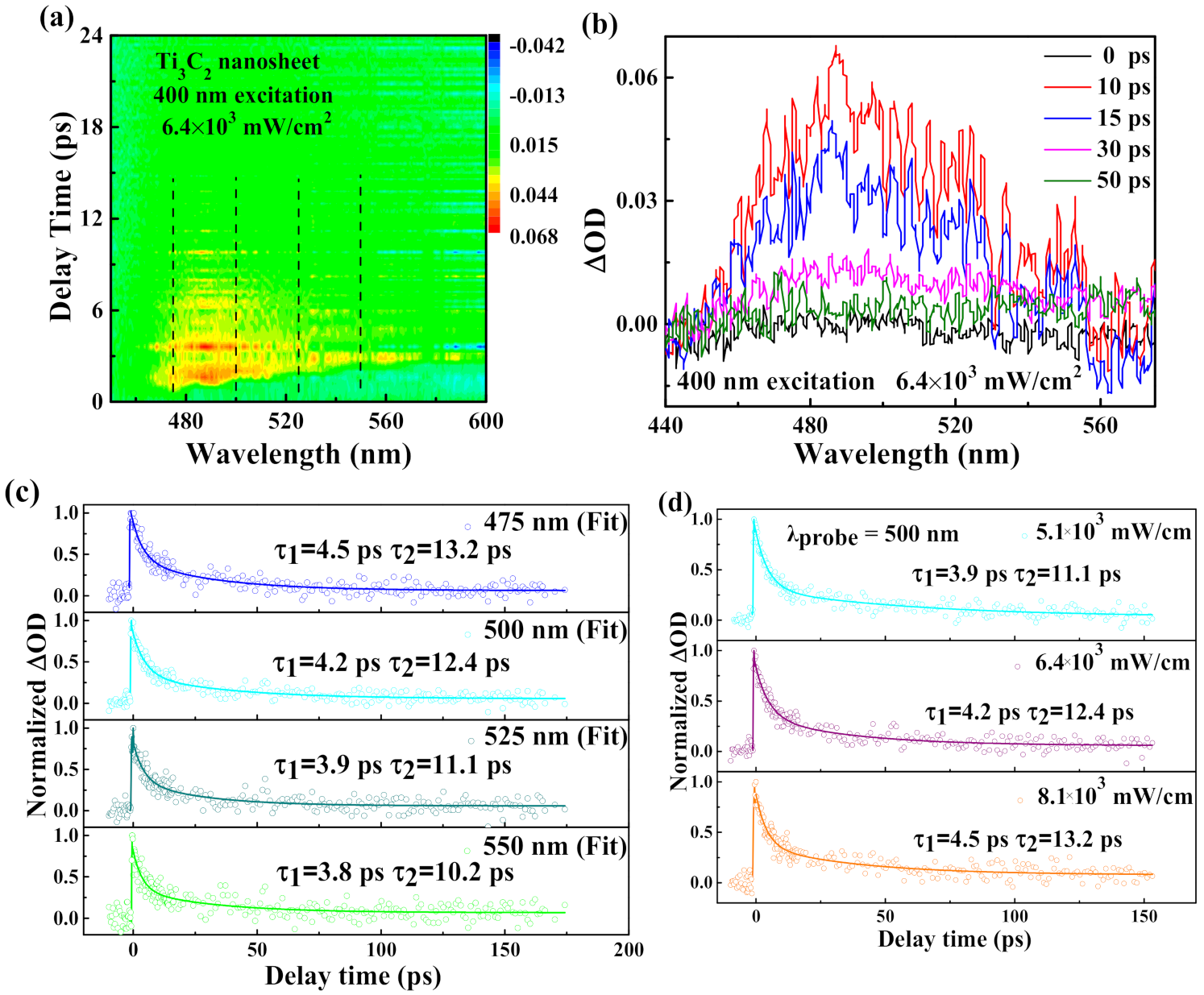Broadband Visible Nonlinear Absorption and Ultrafast Dynamics of the Ti3C2 Nanosheet
Abstract
1. Introduction
2. Materials and Methods
2.1. Preparation of the Ti3C2 Nanosheet
2.2. Optical Experimental Setup
2.2.1. Open-Aperture Z-Scan
2.2.2. Transient Absorption (TA) Spectroscopy
3. Results and Discussions
3.1. Characterization of the Ti3C2 Nanosheet
3.2. The Nonlinear Absorption of the Ti3C2 Nanosheet
3.3. Ultrafast Carrier Dynamics of the Ti3C2 Nanosheet
4. Conclusions
Author Contributions
Funding
Acknowledgments
Conflicts of Interest
References
- Novoselov, K.S.; Geim, A.K.; Morozov, S.V.; Jiang, D.; Zhang, Y.; Dubonos, S.V.; Grigorieva, I.V.; Firsov, A.A. Electric field effect in atomically thin carbon films. Science 2004, 306, 666–669. [Google Scholar] [CrossRef]
- Liu, M.; Yin, X.; Ulin-Avila, E.; Geng, B.; Zentgraf, T.; Ju, L.; Wang, F.; Zhang, X. A graphene-based broadband optical modulator. Nature 2011, 474, 64. [Google Scholar] [CrossRef]
- Bao, Q.; Zhang, H.; Wang, Y.; Ni, Z.; Yan, Y.; Shen, Z.X.; Loh, K.P.; Tang, D.Y. Atomic-layer graphene as a saturable absorber for ultrafast pulsed lasers. Adv. Funct. Mater. 2009, 19, 3077–3083. [Google Scholar] [CrossRef]
- Constant, T.J.; Hornett, S.M.; Chang, D.E.; Hendry, E. All-optical generation of surface plasmons in graphene. Nat. Phys. 2016, 12, 124. [Google Scholar] [CrossRef]
- Naguib, M.; Kurtoglu, M.; Presser, V.; Lu, J.; Niu, J.; Heon, M.; Hultman, L.; Gogotsi, Y.; Barsoum, M.W. Two-dimensional nanocrystals produced by exfoliation of Ti3AlC2. Adv. Mater. 2011, 23, 4248–4253. [Google Scholar] [CrossRef]
- Iliopoulos, K.; Czaplicki, R.; Ouazzani, H.E.; Balandier, J.Y.; Chas, M.; Goeb, S.; Sallé, M.; Gindre, D.; Sahraoui, B. Physical origin of the third order nonlinear optical response of orthogonal pyrrolo-tetrathiafulvalene derivatives. Appl. Phys. Lett. 2010, 97, 101104. [Google Scholar] [CrossRef]
- Iliopoulos, K.; Guezguez, I.; Kerasidou, A.P.; El-Ghayoury, A.; Branzea, D.; Nita, G.; Avarvari, N.; Belmabrouk, H.; Couris, S.; Sahraoui, B. Effect of metal cation complexation on the nonlinear optical response of an electroactive bisiminopyridine ligand. Dyes Pigments 2014, 101, 229–233. [Google Scholar] [CrossRef]
- Kulyk, B.; Guichaoua, D.; Ayadi, A.; El-Ghayoury, A.; Sahraoui, B. Functionalized azo-based iminopyridine rhenium complexes for nonlinear optical performance. Dyes Pigments 2017, 145, 256–262. [Google Scholar] [CrossRef]
- Jiang, T.; Yin, K.; Wang, C.; You, J.; Ouyang, H.; Miao, R.; Zhang, C.; Wei, K.; Li, H.; Chen, H. Ultrafast fiber lasers mode-locked by two-dimensional materials: Review and prospect. Photonics Res. 2020, 8, 78–90. [Google Scholar] [CrossRef]
- Keller, U. Recent developments in compact ultrafast lasers. Nature 2003, 424, 831–838. [Google Scholar] [CrossRef]
- Mashtalir, O.; Naguib, M.; Mochalin, V.N.; Dall’Agnese, Y.; Heon, M.; Barsoum, M.W.; Gogotsi, Y. Intercalation and delamination of layered carbides and carbonitrides. Nat. Commun. 2013, 4, 1716. [Google Scholar] [CrossRef]
- Lukatskaya, M.R.; Mashtalir, O.; Ren, C.E.; Dall’Agnese, Y.; Rozier, P.; Taberna, P.L.; Naguib, M.; Simon, P.; Barsoum, M.W.; Gogotsi, Y. Cation intercalation and high volumetric capacitance of two-dimensional titanium carbide. Science 2013, 341, 1502–1505. [Google Scholar] [CrossRef]
- Shahzad, F.; Alhabeb, M.; Hatter, C.B.; Anasori, B.; Hong, S.M.; Koo, C.M.; Gogotsi, Y. Electromagnetic interference shielding with 2D transition metal carbides (MXenes). Science 2016, 353, 1137–1140. [Google Scholar] [CrossRef]
- Peng, Q.; Guo, J.; Zhang, Q.; Xiang, J.; Liu, B.; Zhou, A.; Liu, R.; Tian, Y. Unique lead adsorption behavior of activated hydroxyl group in two-dimensional titanium carbide. J. Am. Chem. Soc. 2014, 136, 4113–4116. [Google Scholar] [CrossRef]
- Enyashin, A.; Ivanovskii, A. Two-dimensional titanium carbonitrides and their hydroxylated derivatives: Structural, electronic properties and stability of MXenes Ti3C2−xNx(OH)2 from DFTB calculations. J. Solid State Chem. 2013, 207, 42–48. [Google Scholar] [CrossRef]
- Lashgari, H.; Abolhassani, M.; Boochani, A.; Elahi, S.; Khodadadi, J. Electronic and optical properties of 2D graphene-like compounds titanium carbides and nitrides: DFT calculations. Solid State Commun. 2014, 195, 61–69. [Google Scholar] [CrossRef]
- Mauchamp, V.; Bugnet, M.; Bellido, E.P.; Botton, G.A.; Moreau, P.; Magne, D.; Naguib, M.; Cabioc’h, T.; Barsoum, M.W. Enhanced and tunable surface plasmons in two-dimensional Ti3C2 stacks: Electronic structure versus boundary effects. Phys. Rev. B 2014, 89, 235428. [Google Scholar] [CrossRef]
- Berdiyorov, G. Optical properties of functionalized Ti3C2T2 (T= F, O, OH) MXene: First-principles calculations. AIP Adv. 2016, 6, 055105. [Google Scholar] [CrossRef]
- Hantanasirisakul, K.; Zhao, M.Q.; Urbankowski, P.; Halim, J.; Anasori, B.; Kota, S.; Ren, C.E.; Barsoum, M.W.; Gogotsi, Y. Fabrication of Ti3C2Tx MXene transparent thin films with tunable optoelectronic properties. Adv. Electron. Mater. 2016, 2, 1600050. [Google Scholar] [CrossRef]
- Dillon, A.D.; Ghidiu, M.J.; Krick, A.L.; Griggs, J.; May, S.J.; Gogotsi, Y.; Barsoum, M.W.; Fafarman, A.T. Highly conductive optical quality solution-processed films of 2D titanium carbide. Adv. Funct. Mater. 2016, 26, 4162–4168. [Google Scholar] [CrossRef]
- Jhon, Y.I.; Koo, J.; Anasori, B.; Seo, M.; Lee, J.H.; Gogotsi, Y.; Jhon, Y.M. Metallic MXene Saturable Absorber for Femtosecond Mode-Locked Lasers. Adv. Mater. 2017, 29, 1702496. [Google Scholar] [CrossRef]
- Jiang, X.; Liu, S.; Liang, W.; Luo, S.; He, Z.; Ge, Y.; Wang, H.; Cao, R.; Zhang, F.; Wen, Q. Broadband nonlinear photonics in few-layer MXene Ti3C2Tx (T = F, O, or OH). Laser Photonics Rev. 2018, 12, 1700229. [Google Scholar] [CrossRef]
- Dong, Y.; Chertopalov, S.; Maleski, K.; Anasori, B.; Hu, L.; Bhattacharya, S.; Rao, A.M.; Gogotsi, Y.; Mochalin, V.N.; Podila, R. Saturable absorption in 2D Ti3C2 MXene thin films for passive photonic diodes. Adv. Mater. 2018, 30, 1705714. [Google Scholar] [CrossRef]
- Li, J.; Zhang, Z.; Du, L.; Miao, L.; Yi, J.; Huang, B.; Zou, Y.; Zhao, C.; Wen, S. Highly stable femtosecond pulse generation from a MXene Ti3C2Tx (T = F, O, or OH) mode-locked fiber laser. Photonics Res. 2019, 7, 260–264. [Google Scholar] [CrossRef]
- Feng, X.-Y.; Ding, B.-Y.; Liang, W.-Y.; Zhang, F.; Ning, T.-Y.; Liu, J.; Zhang, H. MXene Ti3C2Tx absorber for a 1.06 μm passively Q-switched ceramic laser. Laser Phys. Lett. 2018, 15, 085805. [Google Scholar] [CrossRef]
- Yi, J.; Du, L.; Li, J.; Yang, L.; Hu, L.; Huang, S.; Dong, Y.; Miao, L.; Wen, S.; Mochalin, V.N. Unleashing the potential of Ti2CT x MXene as a pulse modulator for mid-infrared fiber lasers. 2D Mater. 2019, 6, 045038. [Google Scholar] [CrossRef]
- Song, Y.; Chen, Y.; Jiang, X.; Ge, Y.; Wang, Y.; You, K.; Wang, K.; Zheng, J.; Ji, J.; Zhang, Y. Nonlinear few-layer MXene-assisted all-optical wavelength conversion at telecommunication band. Adv. Opt. Mater. 2019, 7, 1801777. [Google Scholar] [CrossRef]
- Yang, Q.; Zhang, F.; Zhang, N.; Zhang, H. Few-layer MXene Ti3C2Tx (T=F, O, or OH) saturable absorber for visible bulk laser. Opt. Mater. Express 2019, 9, 1795–1802. [Google Scholar] [CrossRef]
- Hao, Q.; Liu, J.; Zhang, Z.; Zhang, B.; Zhang, F.; Yang, J.; Liu, J.; Su, L.; Zhang, H. Mid-infrared Er: CaF2–SrF2 bulk laser Q-switched by MXene Ti3C2Tx absorber. Appl. Phys. Express 2019, 12, 085506. [Google Scholar] [CrossRef]
- Li, J.; Zhang, Z.; Yi, J.; Miao, L.; Huang, J.; Zhang, J.; He, Y.; Huang, B.; Zhao, C.; Zou, Y.; et al. Broadband spatial self-phase modulation and ultrafast response of MXene Ti3C2Tx (T=O, OH or F). Nanophotonics 2020, 9, 2415. [Google Scholar] [CrossRef]
- Zhang, H. Ultrathin Two-Dimensional Nanomaterials. ACS Nano 2015, 9, 9451–9469. [Google Scholar] [CrossRef]
- Shao, Y.; Chen, C.; Han, J.; Kong, D.; Gao, Y. Wavelength-dependent nonlinear absorption and ultrafast dynamics process of WS2. OSA Contin. 2019, 2, 2755–2763. [Google Scholar] [CrossRef]
- Wu, W.; Zhou, Y.; Wang, J.; Shao, Y.; Wang, Y. The pump fluence and wavelength-dependent ultrafast carrier dynamics and optical nonlinear absorption in black phosphorus nanosheets. Nanophotonics 2020, 9, 2033–2043. [Google Scholar] [CrossRef]
- Ghidiu, M.; Lukatskaya, M.R.; Zhao, M.Q.; Gogotsi, Y.; Barsoum, M.W. Conductive two-dimensional titanium carbide ‘clay’ with high volumetric capacitance. Nature 2014, 516, 78–81. [Google Scholar] [CrossRef]
- Naguib, M.; Gogotsi, Y. Synthesis of two-dimensional materials by selective extraction. Acc. Chem. Res. 2015, 48, 128–135. [Google Scholar] [CrossRef]
- Hu, Q.; Sun, D.; Wu, Q.; Wang, H.; Wang, L.; Liu, B.; Zhou, A.; He, J. MXene: A new family of promising hydrogen storage medium. J. Phys. Chem. A 2013, 117, 14253–14260. [Google Scholar] [CrossRef]
- Gao, L.; Chen, H.; Zhang, F.; Mei, S.; Zhang, Y.; Bao, W.; Ma, C.; Yin, P.; Guo, J.; Jiang, X.; et al. Ultrafast Relaxation Dynamics and Nonlinear Response of Few-Layer Niobium Carbide MXene. Small Methods 2020, 4, 2000250. [Google Scholar] [CrossRef]
- Wang, G.; Bennett, D.; Zhang, C.; Coileain, C.O.; Liang, M.; Mcevoy, N.; Wang, J.J.; Wang, J.; Wang, K.; Nicolosi, V. Two-Photon Absorption in Monolayer MXenes. Adv. Opt. Mater. 2020, 8, 1902021. [Google Scholar] [CrossRef]
- Kulyk, B.; Waszkowska, K.; Busseau, A.; Villegas, C.; Hudhomme, P.; Dabos-Seignon, S.; Zawadzka, A.; Legoupy, S.; Sahraoui, B. Penta(zinc porphyrin)[60]fullerenes: Strong reverse saturable absorption for optical limiting applications. Appl. Surf. Sci. 2020, 533, 147468. [Google Scholar] [CrossRef]
- Gao, Y.; Zhang, X.; Li, Y.; Liu, H.; Wang, Y.; Chang, Q.; Jiao, W.; Song, Y. Saturable absorption and reverse saturable absorption in platinum nanoparticles. Opt. Commun. 2005, 251, 429–433. [Google Scholar] [CrossRef]
- Sheik-Bahae, M.; Said, A.A.; Wei, T.; Hagan, D.J.; Stryland, E.W.V. Sensitive measurement of optical nonlinearities using a single beam. IEEE J. Quantum Electron. 1990, 26, 760–769. [Google Scholar] [CrossRef]
- Wang, J.; Ding, T.; Wu, K. Charge transfer from n-doped nanocrystals: Mimicking intermediate events in multielectron photocatalysis. J. Am. Chem. Soc. 2018, 140, 7791–7794. [Google Scholar] [CrossRef]
- Wu, K.; Chen, J.; McBride, J.R.; Lian, T. Efficient hot-electron transfer by a plasmon-induced interfacial charge-transfer transition. Science 2015, 349, 632–635. [Google Scholar] [CrossRef]
- Xie, Z.; Zhang, F.; Liang, Z.; Fan, T.; Li, Z.; Jiang, X.; Chen, H.; Li, J.; Zhang, H. Revealing of the ultrafast third-order nonlinear optical response and enabled photonic application in two-dimensional tin sulfide. Photonics Res. 2019, 7, 494–502. [Google Scholar] [CrossRef]
- Lu, S.; Sui, L.; Liu, Y.; Yong, X.; Xiao, G.; Yuan, K.; Liu, Z.; Liu, B.; Zou, B.; Yang, B. White Photoluminescent Ti3C2 MXene Quantum Dots with Two-Photon Fluorescence. Adv. Sci. 2019, 6, 1801470. [Google Scholar] [CrossRef]
- Wibmer, L.; Lages, S.; Unruh, T.; Guldi, D.M. Excitons and Trions in One-Photon- and Two-Photon-Excited MoS2: A Study in Dispersions. Adv. Mater. 2018, 30, 1706702. [Google Scholar] [CrossRef]
- Guo, J.; Shi, R.; Wang, R.; Wang, Y.; Zhang, F.; Wang, C.; Chen, H.; Ma, C.; Wang, Z.; Ge, Y.; et al. Graphdiyne-Polymer Nanocomposite as a Broadband and Robust Saturable Absorber for Ultrafast Photonics. Laser Photonics Rev. 2020, 14, 1900367. [Google Scholar] [CrossRef]
- Breusing, M.; Ropers, C.; Elsaesser, T. Ultrafast Carrier Dynamics In Graphite. Phys. Rev. Lett. 2009, 102, 210–213. [Google Scholar] [CrossRef]
- Ge, Y.; Xu, Q.-H.; Guo, Z.; Zeng, Z.; Yu, X.-F. Size-dependent nonlinear optical properties of black phosphorus nanosheets and their applications in ultrafast photonics. J. Mater. Chem. C. Mater. Opt. Electron. Devices 2017, 5, 3007–3013. [Google Scholar] [CrossRef]
- Brongersma, M.L.; Halas, N.J.; Nordlander, P. Plasmon-induced hot carrier science and technology. Nat. Nanotechnol. 2015, 10, 25–34. [Google Scholar] [CrossRef]
- Urayama, J.; Norris, T.B.; Singh, J.; Bhattacharya, P. Observation of Phonon Bottleneck in Quantum Dot Electronic Relaxation. Phys. Rev. Lett. 2001, 86, 4930–4933. [Google Scholar] [CrossRef]
- Wang, J.; Wu, C.; Dai, Y.; Zhao, Z.; Wang, A.; Zhang, T.; Wang, Z.L. Achieving ultrahigh triboelectric charge density for efficient energy harvesting. Nat. Commun. 2017, 8, 88. [Google Scholar] [CrossRef]
- Kameyama, T.; Sugiura, K.; Kuwabata, S.; Okuhata, T.; Tamai, N.; Torimoto, T. Hot electron transfer in Zn–Ag–In–Te nanocrystal–methyl viologen complexes enhanced with higher-energy photon excitation. RSC Adv. 2020, 10, 16361–16365. [Google Scholar] [CrossRef]




| λ (nm) | I0 (10−2 GW/cm2) | β (10−9 cm/mW) | λ (nm) | I0 (10−2GW/m2) | β (10−9 cm/mW) |
|---|---|---|---|---|---|
| 475 | 0.10 | - | 500 | 0.74 | 1.03 ± 0.08 |
| 475 | 0.30 | 0.31 ± 0.04 | 500 | 1.10 | 1.32 ± 0.10 |
| 475 | 0.50 | 1.80 ± 0.11 | 500 | 1.40 | 1.93 ± 0.13 |
| 550 | 0.74 | 0.91 ± 0.06 | 600 | 0.74 | - |
| 550 | 1.10 | 1.12 ± 0.09 | 600 | 1.10 | 0.41 ± 0.05 |
| 550 | 1.40 | 1.81 ± 0.12 | 600 | 1.40 | 0.78 ± 0.06 |
| 650 | 0.74 | 0.84 ± 0.06 | 700 | 0.74 | - |
| 650 | 1.10 | 0.91 ± 0.07 | 700 | 1.10 | - |
| 650 | 1.40 | 1.65 ± 0.10 | 700 | 1.40 | 0.45 ± 0.04 |
Publisher’s Note: MDPI stays neutral with regard to jurisdictional claims in published maps and institutional affiliations. |
© 2020 by the authors. Licensee MDPI, Basel, Switzerland. This article is an open access article distributed under the terms and conditions of the Creative Commons Attribution (CC BY) license (http://creativecommons.org/licenses/by/4.0/).
Share and Cite
Shao, Y.; Chen, C.; He, Q.; Wu, W.; Li, C.; Gao, Y. Broadband Visible Nonlinear Absorption and Ultrafast Dynamics of the Ti3C2 Nanosheet. Nanomaterials 2020, 10, 2544. https://doi.org/10.3390/nano10122544
Shao Y, Chen C, He Q, Wu W, Li C, Gao Y. Broadband Visible Nonlinear Absorption and Ultrafast Dynamics of the Ti3C2 Nanosheet. Nanomaterials. 2020; 10(12):2544. https://doi.org/10.3390/nano10122544
Chicago/Turabian StyleShao, Yabin, Chen Chen, Qing He, Wenzhi Wu, Chensha Li, and Yachen Gao. 2020. "Broadband Visible Nonlinear Absorption and Ultrafast Dynamics of the Ti3C2 Nanosheet" Nanomaterials 10, no. 12: 2544. https://doi.org/10.3390/nano10122544
APA StyleShao, Y., Chen, C., He, Q., Wu, W., Li, C., & Gao, Y. (2020). Broadband Visible Nonlinear Absorption and Ultrafast Dynamics of the Ti3C2 Nanosheet. Nanomaterials, 10(12), 2544. https://doi.org/10.3390/nano10122544





